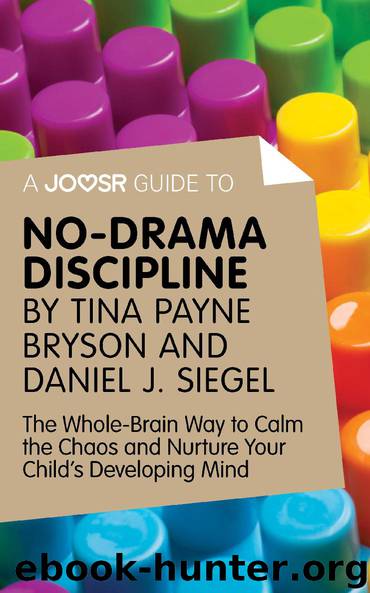No-Drama Discipline by Tina Payne Bryson & Daniel J. Siegel

Author:Tina Payne Bryson & Daniel J. Siegel
Language: eng
Format: epub
Publisher: Joosr Ltd
Remember to keep things simple and focus on the positives—and try including your child in discipline
There are six key strategies that will allow you to discipline your child without any drama. By following these strategies, you can effectively redirect their behavior, while building healthy connections in their brain and also developing a good relationship with them.
Reduce your words. Lecturing leads to children switching off, or even worse, it overloads them with sensory input—so keep your words short and sweet.
Accept emotions. We should acknowledge our child’s emotions and allow them to have them, while helping them to understand that acting on their emotions is not always okay. For example: “I know that you are really mad with your brother and you are upset that he broke your Lego tower, but it is not okay to push him over.”
Describe what you see. So, if your child is supposed to tidy their room before having their bedtime story each night, you should simply say, “I see quite a few toys on the floor in here,” rather than, “You need to tidy up before we can start the story.” This strategy encourages the child to decide how to respond, engaging their upper brain. It also avoids putting the child on the defensive.
Include your child in discipline by asking them what they can do to improve a situation. Going back to the drawing on the wall incident, you could ask, “Next time you want to crayon a big picture, what could you do instead of drawing on the wall?” They may suggest that they chalk in the yard, or come to ask you for a grocery box to color. This will help them to consider their actions and alternative behavior.
Say yes! Suppose your child is acting up and asking for another bedtime story. Instead of simply saying no, look for an opportunity to say yes: “Yes, we can enjoy another story in the morning, when we have all had some rest.”
Focus on the positive. Instead of asking our child to not do something, ask them to do something. “Stop shouting” could become “Use your lovely indoors voice please.” “Don’t run off again” could become “Stay here and hold my hand so we can walk together.” It is simply about reframing things in a more positive light, instead of focusing on the negative behavior.
Download
This site does not store any files on its server. We only index and link to content provided by other sites. Please contact the content providers to delete copyright contents if any and email us, we'll remove relevant links or contents immediately.
Rewire Your Anxious Brain by Catherine M. Pittman(18553)
Talking to Strangers by Malcolm Gladwell(13222)
The Art of Thinking Clearly by Rolf Dobelli(10224)
Mindhunter: Inside the FBI's Elite Serial Crime Unit by John E. Douglas & Mark Olshaker(9201)
Becoming Supernatural by Dr. Joe Dispenza(8119)
Change Your Questions, Change Your Life by Marilee Adams(7635)
Nudge - Improving Decisions about Health, Wealth, and Happiness by Thaler Sunstein(7615)
The Road Less Traveled by M. Scott Peck(7522)
The Lost Art of Listening by Michael P. Nichols(7408)
Enlightenment Now: The Case for Reason, Science, Humanism, and Progress by Steven Pinker(7237)
Mastermind: How to Think Like Sherlock Holmes by Maria Konnikova(7227)
Win Bigly by Scott Adams(7094)
The Way of Zen by Alan W. Watts(6506)
Daring Greatly by Brene Brown(6447)
Big Magic: Creative Living Beyond Fear by Elizabeth Gilbert(5614)
Grit by Angela Duckworth(5523)
Ego Is the Enemy by Ryan Holiday(5294)
Men In Love by Nancy Friday(5157)
Altered Sensations by David Pantalony(5045)
